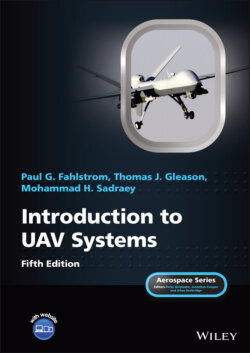Читать книгу Introduction to UAV Systems - Mohammad H. Sadraey - Страница 30
1.3.5 Data Links
ОглавлениеThe data link is a key subsystem for any UAV. The data link for a UAV system provides two‐way communication (i.e., uplink and down link), either upon demand or on a continuous basis. An uplink with a data rate of a few kbps provides control of the air‐vehicle flight path and commands to its payload. The downlink provides both a low data‐rate channel to acknowledge commands and transmit status information about the air vehicle and a high data‐rate channel (1–10 Mbps) for sensor data such as a video camera and radar.
The data link may also be called upon to measure the position of the air vehicle by determining its azimuth and range from the ground‐station antenna. This information is used to assist in navigation and in accurately determining air‐vehicle location (e.g., altitude). Other flight parameters, such as aircraft speed, climb rate, and direction, are often transmitted by a down link to MPCS.
Data links require some kind of anti‐jam and anti‐deception capability if they are to be sure of effectiveness in combat.
The ground data terminal is usually a microwave electronic system and antenna that provides line‐of‐sight communications, sometimes via satellite or other relays, between the MPCS and the air vehicle. It can be co‐located with the MPCS shelter or remote from it. In the case of the remote location, it is usually connected to the MPCS by hard wire (often fiber‐optic cables). The ground terminal transmits guidance and payload commands and receives flight status information (altitude, speed, direction, etc.) and mission payload sensor data (video imagery, target range, lines of bearing, etc.).
The air data terminal is the airborne part of the data link. It includes the transmitter and antenna for transmitting video and air‐vehicle data and the receiver for receiving commands from the ground.
